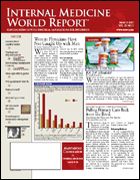Publication
Article
Internal Medicine World Report
Treating Overactive Bladder in Men Requires a New Paradigm
Treating Overactive Bladder in Men Requires a New Paradigm
MONTREAL, Quebec—Physicians are more likely to prescribe drugs indicated for benign prostatic hyperplasia (BPH) than those indicated for overactive bladder (OAB) as first-line therapy when treating OAB symptoms in men, even in those who do not have BPH symptoms, researchers reported at the International Continence Society annual meeting. They noted that anecdotal evidence led to their study. “The use of a large administrative claims database allowed us to evaluate the medical and pharmacy claims of a large OABdiagnosed population and to investigate this question in a real-world setting,” Heidi Harris, MS, then senior research associate at Aetna Health Information Solutions, Blue Bell, Pa, and currently senior research consultant with PharMetrics in Watertown, Mass, told IMWR. “Two notable findings from this study were that
men with OAB are often untreated with drug therapy, and that use of BPH agents is more common in this population than the use of OAB agents, even among patients
with no documented BPH,” she said. A review of a medical and pharmacy claims database of
>30 managed care plans identified 16,998 men who had been newly diagnosed with OAB (aged ≥18 years; ). All patients were required to have been eligible for medical and drug benefits for
1 year before and after their initial diagnosis of OAB. Men with a BPH diagnosis in the year
before and up to the time of their OAB diagnosis were classified as having baseline BPH. Using drug treatment claims from the 12 months after initial OAB diagnosis, patients were categorized into 1 of 4 groups: • OAB drugs only: tolterodine extended (Detrol LA) and immediate release
(Detrol), oxybutynin extended (Ditropan XL) and immediate release (Ditropan); • BPH drugs only: alfuzosin (Uroxatral), doxazosin (Cardura), dutasteride (Avodart), finasteride (Propecia), and tamsulosin (Flomax); • Neither category of drugs; • Both categories of drugs. At the time of OAB diagnosis, 28% of patients also had BPH. Of the 4806 patients with OAB and baseline BPH, 9%
received OAB drugs only, 36% received BPH drugs only, 8% received both, and 47% received neither. Of the 12,192 patients with OAB who did not have BPH at baseline (72%), 11%
received OAB drugs only, 22% received BPH drugs only, 6% received both types, and 61% received neither. The investigators observed that the “use of BPH agents was more common than the use of OAB agents across all study patients; those with baseline BPH were significantly
more likely to be treated with a BPH agent than were those without BPH [P <.001].”
Why are men with OAB unlikely to be treated with drug therapy? “Because they
are diagnosed as BPH and LUTS [lower urinary tract symptoms] or voiding dysfunction
that ensues from prostate gland enlargement and not as OAB, despite the overlap of symptoms,” said Steven Kaplan, MD, professor of urology and chief of the Institute of Bladder and Prostate Health at Weill-Cornell Medical College, New York City. He added that a “new paradigm needs to
emerge.”
